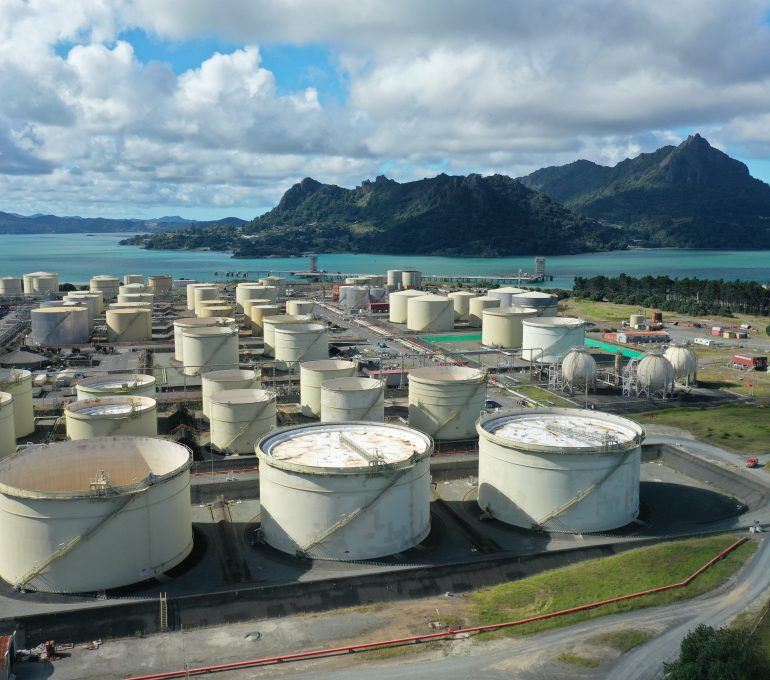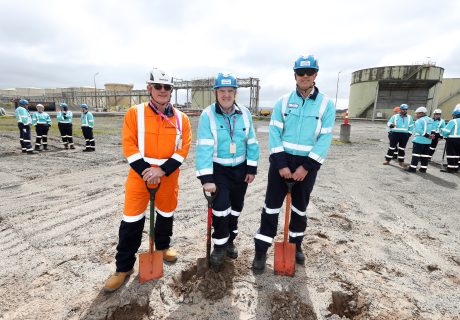Channel is well positioned with a clear plan for growth.
We have strong, stable cash flows and uniquely strategic assets that provide the key fuel supply route to Auckland, with growing demand for jet fuel set to underpin the future of our business. Our plan for growth includes supporting fuel resilience for New Zealand through additional fuel storage on our site, unlocking the strategic value of the Marsden Point Energy Precinct Concept which highlights the significant role for Channel in supporting New Zealand’s energy transition and exploring expansion beyond Marsden Point through the acquisition of other terminals infrastructure in New Zealand.
Supporting resilience for our customers and New Zealand.
Channel is committed to delivering improved resilience for our customers’ supply chains, and to supporting New Zealand’s fuel security in the form of increased fuel storage.
As New Zealand’s largest fuels import terminal we have a key role to play in supporting our customers, underpinning resilience in New Zealand’s fuels supply chain.
With approximately 400 million litres of unutilised storage tanks, as well as significant land, facilities and proven capabilities, we see a real opportunity to provide additional storage for our customers, and in support of the Government’s fuel security ambitions.

The Marsden Point Energy Precinct
Channel’s long-term vision for its Marsden Point site as an Energy Precinct outlines how the Company could accommodate a range of energy projects that would boost New Zealand’s energy resilience and help support the decarbonisation of New Zealand.
The plan highlights the significant role the site could play in supporting New Zealand’s energy transition, through potential opportunities such as additional storage, lower-carbon future fuels manufacture, as well as a range of energy security projects such as electricity firming and storage opportunities.
Click here to download our Marsden Point Energy Precinct graphic.
Channel’s role would be as a precinct landlord with long-term contracted lease income that supplements our infrastructure income, earning an appropriate yield on our land. Strategic tenants would also utilise our existing infrastructure including our jetty, pipeline and storage on our site.
Our plan for growth includes supporting the manufacture of lower-carbon future fuels at Marsden Point to support the energy transition in New Zealand.
New Zealand’s electricity grid is increasingly renewable, and with that comes the challenge of firming that grid. For a site that is consented for electricity generation and well connected to the national transmission grid, we have the opportunity to look at things like diesel peaking, flow batteries, LNG, green hydrogen or green hydrogen carriers for import or export and electricity generation.
Sustainable Aviation Fuel
Sustainable Aviation Fuel (SAF) is emerging as the most technically viable way to bring down aviation emissions for medium to long-haul travel. Given our proximity to Auckland, and critical role in the jet fuel supply chain, we are well positioned to help facilitate the renewable fuel transition in New Zealand. Our partners, Fortescue, are investigating the development of a e-Sustainable Aviation Fuel (eSAF) manufacturing facility that could supply c.60 million litres of eSAF per year – equivalent to more than 3 per cent of the annual jet fuel requirements for the aviation sector in New Zealand.
Our critical infrastructure is capable of handling ‘drop in’ lower-carbon fuels, including second-generation biofuel and SAF. As a ‘drop in’ fuel, SAF can use existing infrastructure such as existing ships, storage tanks, pipelines, and airports, and does not require any changes to the tens of thousands of aircraft currently in use. It is also the lowest cost option for the future.
Marsden Point biorefinery project
Channel Infrastructure has entered into a conditional project development agreement with Seadra Energy Inc, to develop a biorefinery at Channel’s Marsden Point site. The proposed biorefinery, should this project proceed, would sit alongside Fortescue’s proposed e-SAF manufacturing facility and could become an anchor tenant for Channel’s Marsden Point Energy Precinct.
The Seadra biorefinery project would utilise Channel’s decommissioned assets from the hydrocracking complex, as well as newly constructed plant (including to process biological feedstocks). The Seadra Consortium, which includes consortium members Qantas, Renova Inc, Kent Plc, and ANZ, would build, own and operate the plant, and would be responsible for sourcing feedstock, with Channel acting as landlord and ancillary infrastructure provider. The project remains subject to further engineering studies, agreement on commercial terms and final form agreements, completion of funding and final investment decision by the Seadra Consortium and Channel.
Should the Marsden Point biorefinery project proceed, it would create value for shareholders through the sale of decommissioned assets and revenue from long-term contracts for the use of our land and other infrastructure by the biorefinery. The proposed biorefinery project is just one example of the many and varied potential opportunities we see to develop Marsden Point as an Energy Precinct for New Zealand over the long term.
Growth beyond Marsden Point
A core part of our long-term strategy is to consider expansion beyond Marsden Point by acquiring other terminals infrastructure throughout New Zealand. The world-class programme is critical to prove our capabilities and enable us to earn the right to acquire additional assets beyond Marsden Point. We see a real opportunity to support our customers, and the wider energy supply chain through our proven independent infrastructure operator status, and as fuels infrastructure is consolidated around New Zealand.





